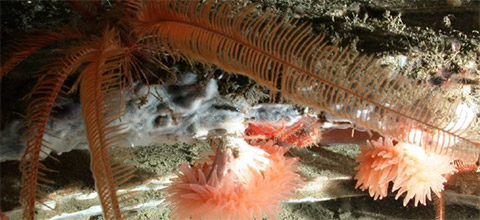Authors:
K. Graiff, D. Lipski, P. Etnoyer, G. Cochrane, G. Williams, and E. Salgado

A large area of the seafloor off northern California lies within the US National Marine Sanctuary System, but very little of the habitat has been explored and even less is characterized using visual survey techniques, especially deep-water habitats. Benthic surveys using a Phantom HD2 remotely operated vehicle (ROV) were conducted during September 2-7, 2014 off the coast of Sonoma County, northern California at dive targets near Bodega Canyon and on a rocky feature informally named “The Football.” The targeted sites are within the northern areas recently added to Cordell Bank and Greater Farallones National Marine Sanctuaries. Information was collected to establish a baseline characterization of these areas that could inform researchers and the sanctuaries’ managers to better understand these deep-water ecosystems. The goals of the ROV surveys were to characterize deep-water benthic habitats, ground truth predicted habitat classifications, ground truth predictive habitat suitability models for coral and fish occurrence, and contribute to education and outreach about deep-water habitats. The sampling scheme was designed to characterize three classes of habitat predicted by multibeam sonar data: 1) hard-rugose (high-relief, hard bottom), 2) hard-flat (low-relief, hard bottom), and 3) soft-flat (low relief, soft bottom). A total of 20 transects were conducted, 9 at the Bodega Canyon site and 11 at The Football site at depths ranging from 180 to 306 meters. Many species of fishes, corals and sponges were documented. At Bodega Canyon at least 30 taxa of fish, 6 coral taxa and 6 sponge taxa were observed. At The Football at least 34 taxa of fish, 5 coral taxa and 4 sponge taxa were observed. A large sedimentary rock outcrop slope with many ledges and overhangs providing an ideal habitat for invertebrates and hundreds of rockfish were observed on The Football transect HC-30. A sea whip commonly seen while surveying The Football was collected and determined to be a new species Swiftia farallonesica. Other interesting observations included large aggregations of catshark and skate egg cases at The Football. Derelict fishing gear was observed at both sites.
Key Words:
California continental shelf, deep-water benthic habitats, corals, sponges, rockfishes, National Marine Sanctuaries, remotely operated vehicle (ROV)

